brake light Oldsmobile Cutlass Supreme 1996 Owner's Manuals
[x] Cancel search | Manufacturer: OLDSMOBILE, Model Year: 1996, Model line: Cutlass Supreme, Model: Oldsmobile Cutlass Supreme 1996Pages: 356, PDF Size: 18.48 MB
Page 7 of 356
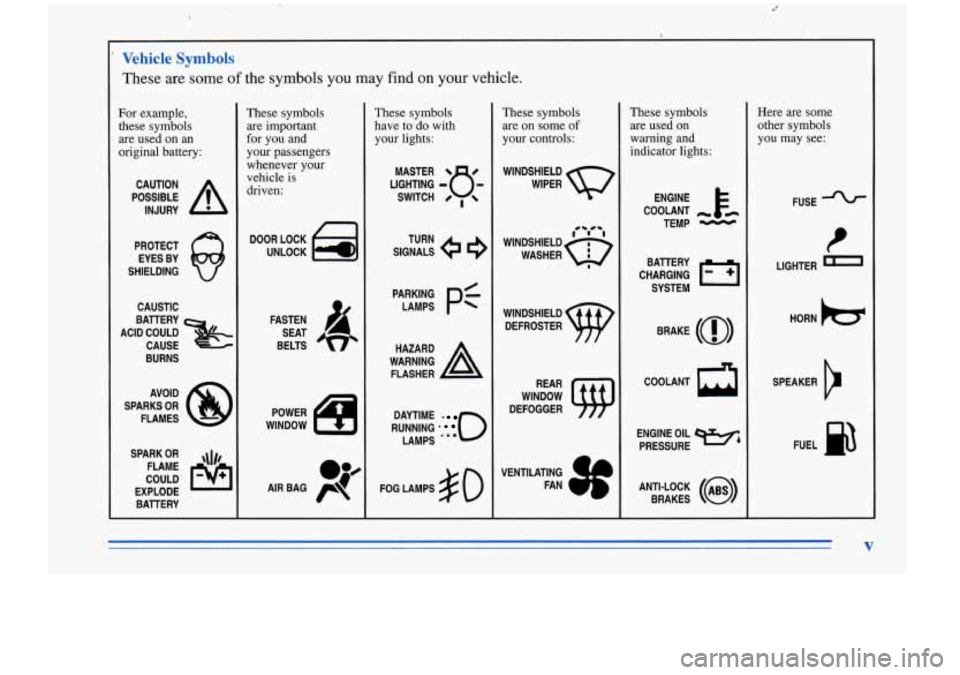
J
Vehicle Symbols
These are some of the symbols you may find on your vehicle.
For example, these symbols
are used on an
original battery:
POSSIBLE A
CAUTION
INJURY
PROTECT EYES BY
SHIELDING
Q
CAUSTIC
BURNS AVOID
SPARKS
OR
FLAMES
SPARK
OR ,\I/,
COULD FLAME
EXPLODE BAllERY
These symbols are important
for you and
your passengers
whenever your
vehicle is
driven:
UNLOCK w.
FASTEN
SEAT
BELTS
POWER
WINDOW
These symbols
have to do with
your lights:
SIGNALS e e3
TURN
RUNNING
* 0
DAYTIME
LAMPS
FOG LAMPS
# 0
These symbols
are on some
of
your controls:
WINDSHIELD
WIPER
WINDOW
DEFOGGER
These symbols are used on
warning and
indicator lights:
COOLANT
TEMP
-
CHARGING I-1
BAllERY
SYSTEM
BRAKE
(a)
COOLANT a
ENGINE OIL w,
PRESSURE
ANTI-LOCK
(@)
BRAKES
Here are some
other symbols
you may see:
FUSE
LIGHTER
m
HORN )tr
SPEAKER
I@
FUEL la
Page 91 of 356
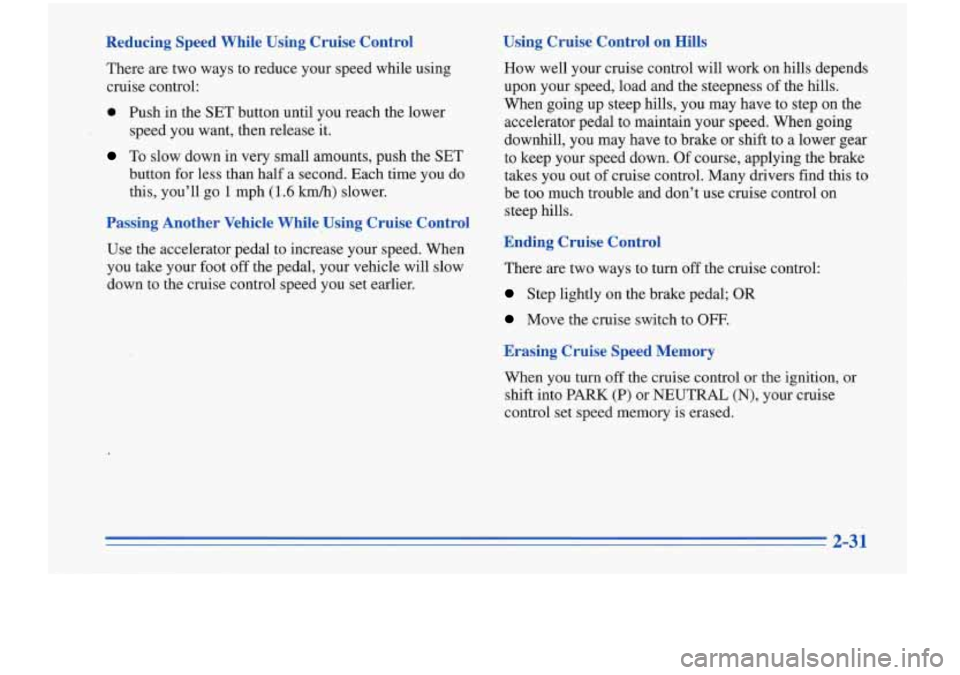
Reducing Speed While Using Cruise Control
There are two ways to reduce your speed while using
cruise control:
0 Push in the SET button until you reach the lower
speed you want, then release it.
To slow down in very small amounts, push the SET
button for less than half a second. Each time you do
this, you'll go
1 mph (1.6 km/h) slower.
Passing Another Vehicle While Using Cruise Control
Use the accelerator pedal to increase your speed. When
you take your foot
off the.peda1, your vehicle will slow
down to the cruise control speed you set earlier.
Using Cruise Control on Hills
How well your cruise control will work on hills depends
upon your speed, load and the steepness
of the hil.ls.
When going up steep hills, you may have to step on the
accelerator pedal to maintain your speed. When going
downhill, you may have to brake or shift to a lower gear
to keep your speed down.
Of course, applying the brake
takes you out of cruise control. Many drivers find this to
be too much trouble and don't use cruise control on
steep hills.
.Ending Cruise Control
There are two ways to turn off the cruise control:
Step lightly on the brake pedal; OR
Move the cruise switch to OFF.
Erasing Cruise Speed Memory
When you turn off the cruise control or the ignition, or
shift into PARK
(P) or NEUTRAL (N), your cruise
control set speed memory is erased.
Page 93 of 356

The DRL system will make your low-beam headlamps
come on at a reduced brightness when:
0 The ignition is on,
0 The headlamp switch is off, and
0 The parking brake is released.
When the DRL are on, only your low-beam headlamp,s
will be on. The taillamps, sidemarker and other lamps
won’t be on. Your instrument panel won’t be lit
up either.
When it’s dark enough outside, your low-beam
headlamps will change to full brightness. The other
lamps that come on with your headlamps will also
come on.
When it’s bright enough outside, the regular lamps will
go out, and your low-beam headlamps will change
to
-the reduced brightness of DIU.
To idle your vehicle with the DRL
off, set the parking
brake while the ignition is in the
OW or LOCK
position. Then start your vehicle. The DRL will stay off
until you release the parking brake.
As with any vehicle, you should turn on the regular
headlamp system when you need it.
Fog Lamps
To turn fog lamps on, press the top of the switch (C). Press the
bottom of the switch to
turn the fog lamps off. Your parking
lamps must be on, or your fog lamps won’t come on.
The fog lamps will go
off whenever you change to
high-beam headlamps. When you return to low beams,
the fog lamps will come
on again.
Interior Lamps
Instrument Panel Brightness Control
You can brighten or dim the instrument panel lights by
moving the instrument panel lights dial.
If you turn the
dial all the way to
INT, your courtesy or interior lamps
will come on.
Courtesy Lamps
When any door is opened, several larnps come on. These
lamps are courtesy lamps. They make it easy for you to
enter and leave your vehicle. You can
also turn these
lamps on by moving the dial near the beadlamp knob all
the way up to
INT.
Some of the lamps have switches so you can turn them
on, even when the doors are closed. These lamps are
reading lamps.
To avoid draining your battery, be sure to ’
turn off all reading lamps when leaving your vehicle.
2-33
Page 107 of 356
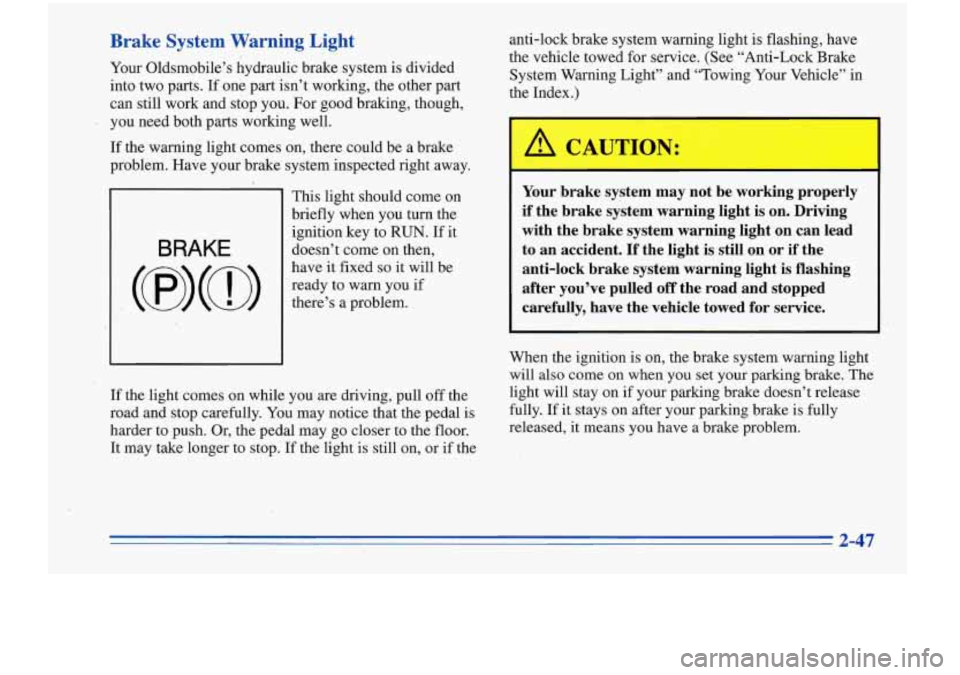
Brake System Warning Light
Your Oldsmobile’s hydraulic brake system is divided
into two parts. If one part isn’t working, the other part
can still work and stop you. For good braking, though,
~ you need both parts workmg well.
If the warning light comes on, there could be
a brake
problem. Have your brake system inspected right away.
BRAKE
This light should come on
briefly when you turn the
ignition key to
RUN. If it
doesn’t come on then,
have
it fixed so it will be
ready to warn you if
there’s a problem.
If the light comes on while you
are driving, pull off the
road and stop carefully. You may notice that the pedal is
harder to push.
Or, the pedal may go closer to the floor.
It may take longer to stop. If the light is still on, or if the anti-lock brake system warning light
is flashing, have
the vehicle towed for service. (See “Anti-Lock Brake
System Warning Light” and “Towing Your Vehicle” in
the Index
.)
1 C.’ UTION:
Your brake system may not be working properly
if the brake system warning light is on. Driving
with the brake system warning light on can lead
to an accident. If the light is still on or if the
anti-lock brake system warning light is flashing
after you’ve pulled
off the road and stopped
carefully, have the vehicle towed for service.
When the ignition is on, the brake system warning light
will also come on when
you set your parking brake. The
light will stay on if your parking brake doesn’t release
fully. If it stays on after your parking brake is fully
released, it means you have a brake problem.
2-47
Page 108 of 356
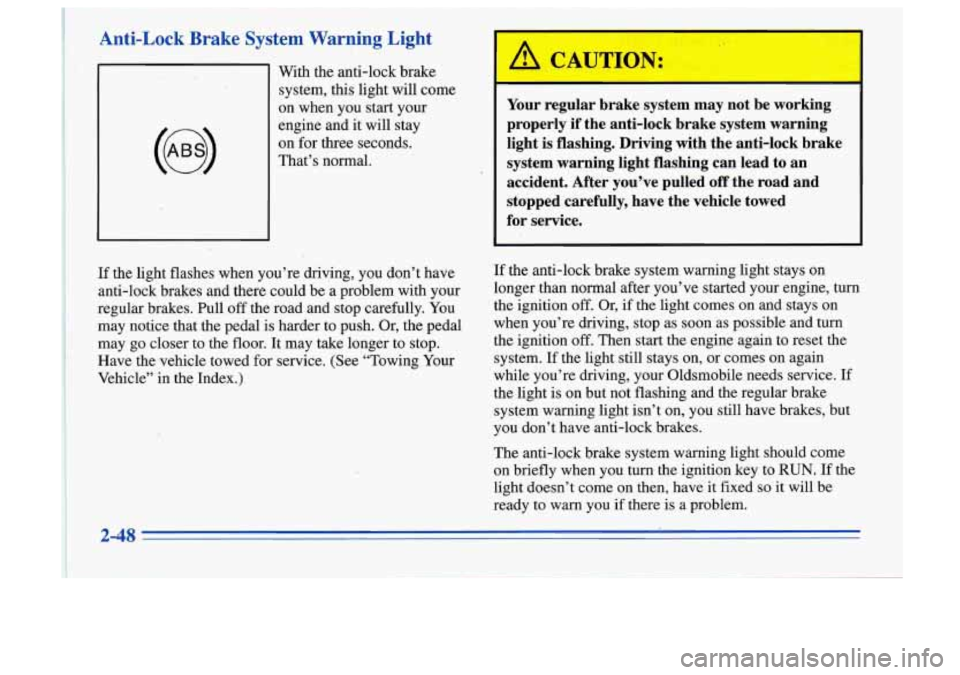
Anti-Lock Brake System Warning Light
With the anti-lock brake system, this light will come
on when you start your
engine and it will stay
on for three seconds.
That’s normal.
If the light flashes when you’re driving, you don’t have
anti-lock brakes and there could be
a problem with your
regular brakes. Pull
off the road and stop carefully. You
may notice that the pedal is harder to push. Or, the pedal
may go closer to the floor. It may take longer to stop.
Vehicle” in the Index.)
, Have the .vehicle towed for service. (See.“Towing Your
Your regular brake system may not be working
properly
if the anti-lock brake system warning
light is flashing. Driving with the anti-lock brake system warning light flashing can lead to an
accident. After you’ve pulled
off the road and
stopped carefully, have the vehicle towed
for service.
If the anti-lock brake system warning light stays on
longer than normal after you’ve started your engine, turn
the ignition
off. Or, if the light comes on and stays on
when you’re driving, stop as soon as possible and turn
the ignition
off. Then start the engine again to reset the
system. If the light still stays on, or comes on again
while you’re driving, your Oldsmobile needs service. If
the light is on but not flashing and the regular brake
system warning light isn’t on, you still have brakes, but
you don’t have anti-lock brakes.
The anti-lock brake system warning light should come
on briefly when you turn the ignition key to
RUN. If the
light doesn’t come on then, have it fixed
so it will be
ready
to warn you if there is a problem.
2-48
Page 109 of 356

Anti-Lock Brake System Active Light
LOW
TRAC
When your anti-lock system
is adjusting brake pressure
to help avoid a braking skid,
the anti-lock brake system
active light will come
on.
Engine Coolant Temperature Light
HOT
This light tells you that
your engine coolant has
overheated or your radiator
cooling fan is not working.
Slippery road conditions may exist if this light comes
on,
so adjust your driving accordingly. The light will
stay on for a few seconds after the system stops
adjusting brake pressure.
The anti-lock brake system active light also comes on
briefly when you turn the ignition key to RUN. If the
light doesn’t come on then, have
it fixed so it will be
there to
tell you when the system is active. If you
have been operating your vehicle under normal
driving conditions, you should pull
off the road, stop
your vehicle and turn
off the engine as soon as possible.
In “Problems on the Road,” this manual shows what to
do. See “Engine Overheating” in the Index.
2-49
Page 154 of 356
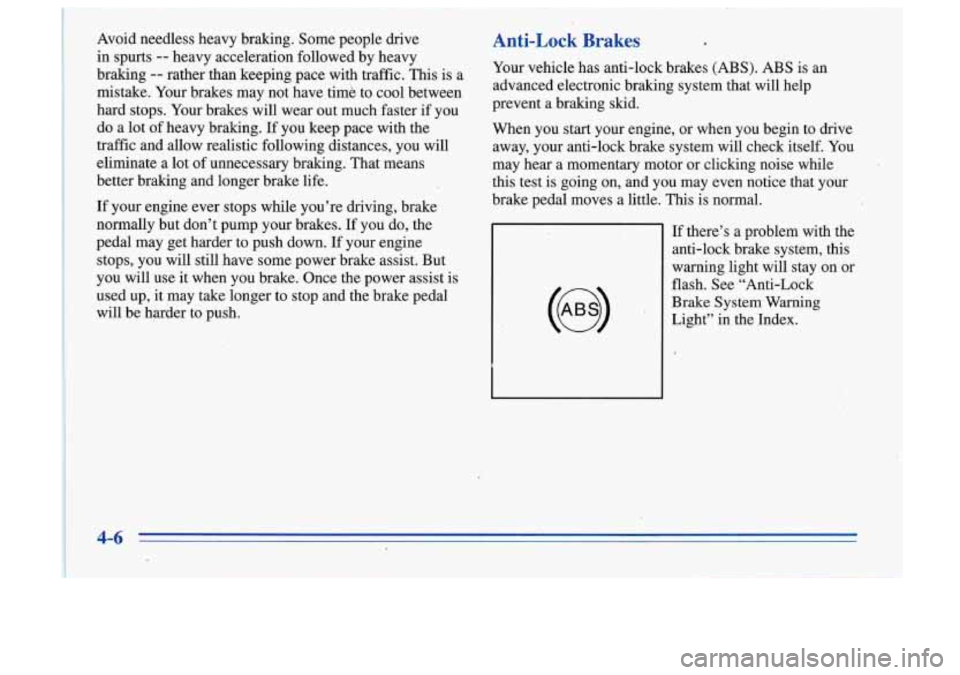
~ ~~~~
~ ~~~ ~ Avoid needless heavy braking.
Some people drive
in spurts
-- heavy acceleration followed by heavy
braking
-- rather than keeping pace with traffic. This is a
mistake. Your brakes may not have time to cool between
hard stops. Your brakes will wear out much faster if you
do a lot of heavy braking. If you keep pace with the
traffic and allow realistic following distances, you will
eliminate a lot
of unnecessary braking. That means
better braking and longer brake life.
If your engine ever stops while you’re driving, brake
normally but don’t pump your brakes. If you do, the
pedal may get harder to push down.
If your engine
stops, you will still have some power brake assist. But
you will use it when you brake. Once the power assist is
used up, it may take longer to stop and the brake pedal
will be harder to push.
_. ~~~~ ~ ~~
~ ~~
Anti-Lock Brakes
Your
vehicle has anti-lock brakes (ABS). ABS is an
advanced electronic braking system that will help
prevent a braking skid.
When you start your engine, or when you begin to drive away, your anti-lock brake system will check itself. You
may hear a momentary motor or clicking noise while
this test is going on, and you may even notice that your
brake pedal moves a little. This is normal.
If there’s a problem with the
anti-lock brake system, this
warning light will stay on or
flash. See “Anti-Lock
Brake System Warning
Light” in the Index.
Page 156 of 356

Remember: Anti-lock doesn’t change the time you need
to get your foot up to the brake pedal or always decrease stopping distance. If you get too close to the vehicle in
front of you, you won’t have time to apply your brakes
if that vehicle suddenly slows or stops. Always leave
enough room up ahead to stop, even though you have
anti-lock brakes.
Using Anti-Lock
Don’t pump the brakes. Just hold the brake pedal
down and let anti-lock work for you.
You may feel the
1 system working, or you may notice some noise, but this
~ is normal.
LOW
TRAC
When your anti-lock system
is adjusting brake pressure
to help avoid a braking skid,
this light will come on.
See
“Anti-Lock Brake System
Active Light” in the Index.
Braking in Emergencies
Use your anti-lock braking system when you need to.
With anti-lock, you can steer and brake at the same
time. In many emergencies, steering can help you more
than even
the very best braking.
Steering
Power Steering
If you lose power steering assist because the engine
stops dr the system is not functioning, you can steer but
it will take much more effort.
Variable Assist Steering (Option)
This steering system provides lighter steering effort for
parking and when driving at low speeds. Steering effort
will increase at higher’speeds for improved road feel.
Steering Tips
Driving on Curves
It’s important to take curves at a reasonable speed.
A lot of the “driver lost control” accidents mentioned on
the news happen on curves. Here’s why:
Page 164 of 356

Driving too fast through large water puddles or even
going through some car washes can cause problems, too.
The water may affect
your brakes. Try to avoid puddles.
But
if you can’t, try to slow down before you hit them.
Wet brakes can cause accidents. They won’t work
well in a quick stop and may cause pulling to one
side. You could lose control of the vehicle.
After driving through a large puddle of water
or
a car wash, apply your brake pedal lightly until
your brakes work normally.
4-16
Page 247 of 356
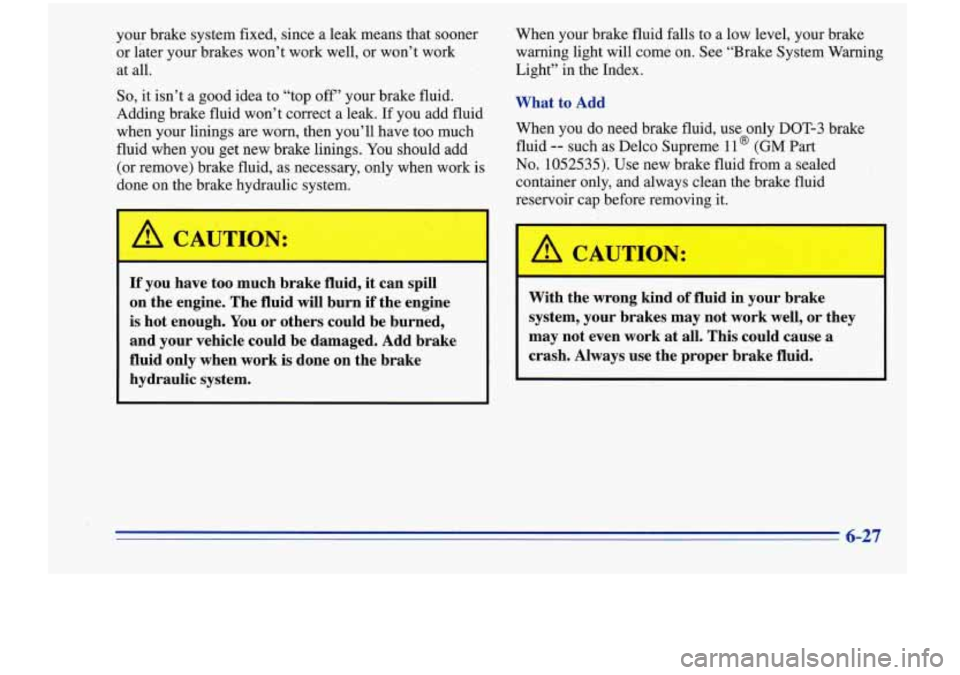
your brake system fixed, since a leak means that sooner
or later your brakes won’t work well, or won’t work
at all.
So, it isn’t a good idea to “top off’ your brake fluid.
Adding brake fluid won’t correct a leak. If you add fluid
when your linings are worn, then you’ll have too much
fluid when you get new brake linings. You should add
(or remove) brake fluid, as necessary, only when work is
done on the brake hydraulic system. When your brake
fluid falls to a low level, your brake
warning light will come on. See “Brake System Warning
Light” in the Index.
What to Add
When you do need brake fluid, use only DOT-3 brake
fluid
-- such as Delco Supreme 11 @ (GM Part
No.’ 1052535). Use new brake fluid from a sealed
container only, and always clean the brake fluid
reservoir cap before removing
it.
A CAUTION:
-
If you have too much brake fluid, it can spill
on the engine. The fluid will burn if the engine
is hot enough. You or others could be burned,
and your vehicle could be damaged. Add brake
fluid only when work is done
on the brake
hydraulic system.
I A CAUTIC’J:
With the wrong kind of fluid in your brake
system, your brakes may not work well, or they
may not even work
at all. This could cause a
crash. Always use the proper brake fluid.
6-27